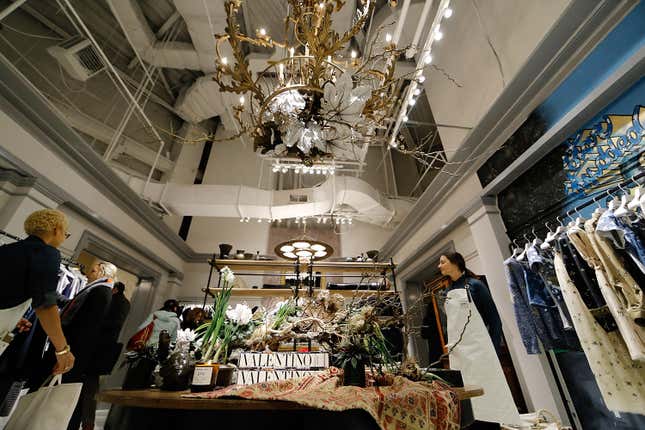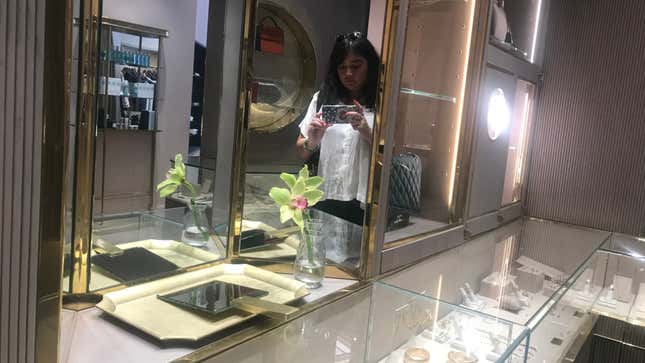The Subtle Class Wars of Gwyneth Paltrow's Goop Lab
Latest

Goop Labs, a Gwyneth Paltrow retail experience plopped in the middle of Soho, was curiously empty on a bright and sunny Wednesday afternoon, save for a woman and her large grey and white standard poodle, splayed in the middle of the floor as if it owned the place.
The woman, standing at the register, gestured towards a large pile of white fabric that I later understood to be a variety of mock turtlenecks that she was insistent upon returning. The cashier was patient with her, tapping at a laptop and listening to her monologue about why these white mock turtlenecks were not the right white mock turtlenecks, the white mock turtleneck to manifest her desire.
Perhaps there’s a metaphor buried in this exchange — the purity of a white mock turtleneck, the audacity to wear one when it’s 86 degrees outside, or the amount of leisure time one must have to be able to show up to Goop Labs at 12:32pm on a Wednesday to complain about the quality of its white mock turtleneck. Or maybe there isn’t. What the exchange, and my remaining twenty minutes or so at Goop Labs, did teach me, though, is how Gwyneth Paltrow thinks we all should live.
What the exchange did teach me, though, is how Gwyneth Paltrow thinks we all should live.
The storefront opened in November 2018, as an extension of Paltrow’s wellness brand Goop. Within its walls is everything that you could ever want, should you desire your personal taste to be replaced by Gwyneth Paltrow’s Farrow and Ball-painted vision of contemporary femininity. If visiting Goop’s website is too pedestrian an experience, the store is functionally immersive: a beautiful apartment that feels like Paltrow’s East Coast pied-a-terre. It’s the diametric opposite of the website’s overbearing minimalism—maybe it’s easier to buy $90 “Madame Ovary” supplements if they’re displayed on a nice shelf in a room that sort of looks like someone’s home. It’s less a store in the traditional sense and more a tribute to the kind of woman Gwyneth Paltrow thinks women should be: glamorous yet very clean, with a healthy supplement regimen and skin clear enough to require the barest hint of makeup. As a permanent brand activation or experiential marketing gambit, it works beautifully, but as a retail store for anything other than casual passers-by, it misses the mark.
To stand in the center of Goop Lab is to feel like you’re intruding in the closet of the nicest apartment you’ve ever visited. Were this a cocktail party and not a store in the middle of Soho, I would’ve opened a medicine cabinet or touched a necklace, just to see how it feels to be rich. But because I was at a store and not a Upper East Side townhouse, I held my bag close to my body and tried not to bump into anything breakable.

Because I was at a store and not a Upper East Side townhouse, I held my bag close to my body and tried not to bump into anything breakable.
To Paltrow’s credit, nothing she has ever said in the press or otherwise has suggested she believes her taste is egalitarian: Goop is aspirational and will remain so because that is how it makes money. To that end, Goop Labs is a perfect distillation of Paltrow’s capitalist vision: full of Carrara marble and custom cabinetry, bathed in flattering light. The store is laid out like a very nice studio apartment in which the inhabitant does not sleep (there’s no bed), or a large walk-in closet of the type seen on MTV’s Cribs. There’s a living room in the front, furnished with two nubby armchairs from Paltrow’s line at CB2; I did not sit on them because I was one of the only people in the store and it felt improper for me to do so.
There were clothes in the front and shoes and handbags stacked atop coffee table books—a pernicious trend in interior design that should disappear forever because you cannot read the books. Chanel bags that may or may not have been for sale were displayed above glass jewelry cases, evoking the closet of a wealthy woman with relatively basic tastes, or a museum constructed in monument to the art of integrating pavé diamonds onto absolutely everything. The back contained the kitchen portion as well as more beauty products, some of which I considered buying but did not.
Goop doesn’t pretend to be egalitarian.
I was not pressured to purchase any of the things I touched and no one hovered near me as I sniffed every single perfume available in the store. To be unbothered by a retail associate is a gift in and of itself, and for that small pleasure, I remain grateful. But the experience of shopping in a store as fancy and as expensive as Goop Labs highlights the kind of class anxiety that years of living in New York City should have eradicated. Shopping at Goop Labs is meant to make the consumer feel wealthy enough to be in the space in the first place, and therefore to have the confidence money affords. Because the experience is designed to blur the lines between public (a store) and private (your own home), “shopping” in the liminal space feels rather like snooping in an apartment of the sort that I’ll never own. Gauche, crass commerce—a shopping mall with sale signs and an Auntie Anne’s next to the Zales—is absent. If you’re not comfortable in the kind of rarefied spaces that Goop Labs presents, then the experience of being in the store is inherently uncomfortable by design.
Paltrow’s messaging around her brand makes it clear that her goal isn’t necessarily to make everyone comfortable; with that in mind, Goop Labs is a perfect extrusion of her exacting vision.